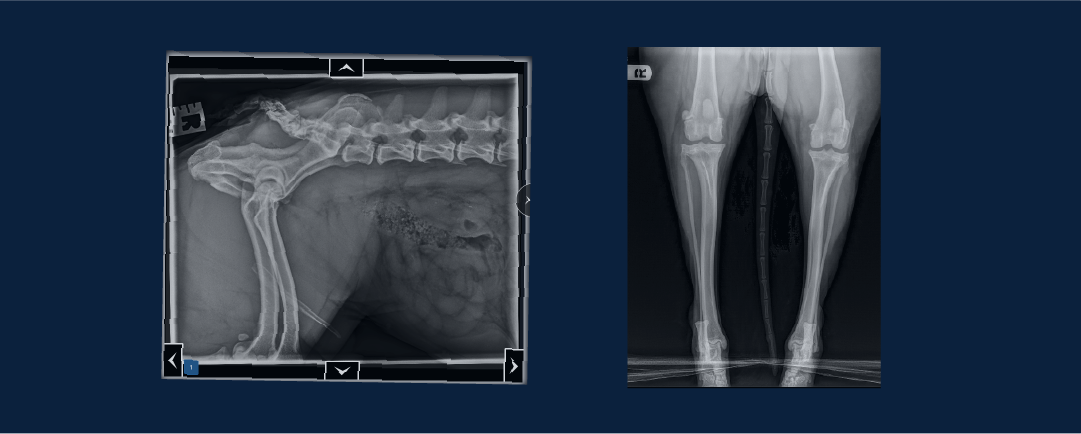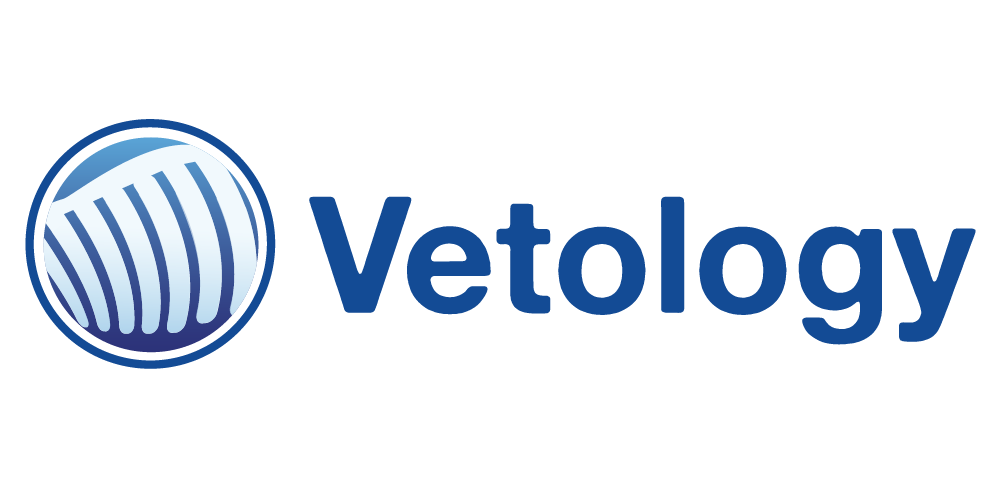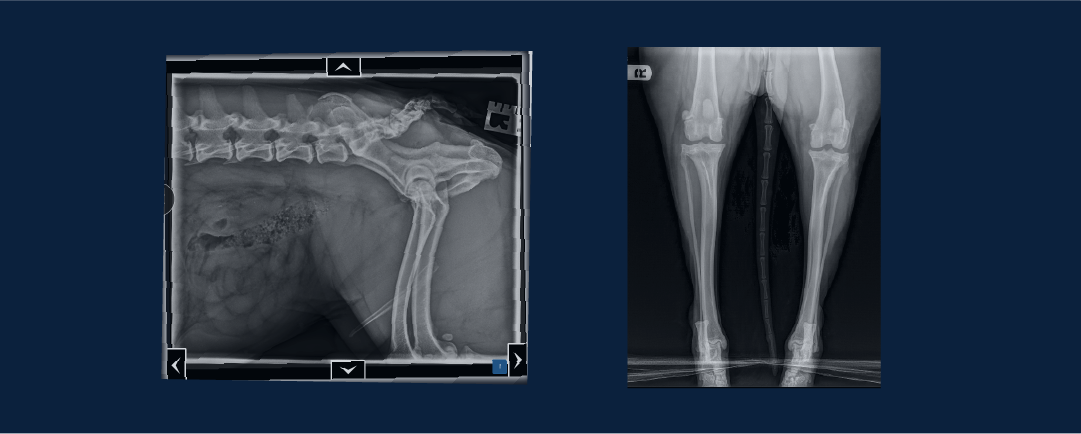Artificial intelligence is transforming veterinary imaging through the use of classifiers—AI tools trained to detect patterns and abnormalities in radiographs. Vetology’s AI veterinary diagnostic system supports, rather than replaces, veterinary expertise by delivering screening results to enhance diagnostic workflows. In this article you will learn how:
- Classifiers flag potential issues in images, offering screening support.
- Vetology trains classifiers using verified “golden sets” of radiographs reviewed by expert radiologists.
- Image quality directly affects the accuracy of AI analysis and results.
- Vetology’s AI supports vets by confirming findings, guiding next steps, and improving diagnostic workflow.
How Classifiers Work: The Role of AI in Imaging and Clinical Practice
Artificial Intelligence (AI) is starting to become an integral tool in veterinary imaging. At the heart of this technology lies the concept of classifiers—AI models trained to recognize specific patterns or anomalies in imaging studies.
Understanding how classifiers work, their limitations, and how they complement the veterinary workflow is key to appreciating the value AI imaging support brings to patient care.
What Are Classifiers?
Classifiers are AI algorithms designed to identify specific features or abnormalities in diagnostic images. For example, a classifier might detect signs of pulmonary patterns, foreign bodies, or changes in organ size. However, it is essential to understand that Vetology’s classifiers generate screening results, not diagnostic conclusions. Their purpose is to aid veterinarians by highlighting potential areas of concern and guiding further investigation or treatment planning.
How Are Classifiers Trained?
The effectiveness of a classifier depends entirely on the quality and breadth of its training. In Vetology’s approach, classifiers are trained using what is called a golden set of radiographs. A golden set consists of high-quality imaging studies that have been meticulously reviewed and confirmed by radiologists to feature the specific condition of interest. This ensures that the AI learns from confirmed, representative examples.
For instance, in developing a classifier to detect hepatomegaly in feline patients, we curate a golden set that includes radiographs of cats with confirmed hepatomegaly. This focused training enables the AI to recognize the subtle features specific to the condition in cats, such as changes in liver size or contour. Conversely, for conditions such as fractures, we use images from both dogs and cats to develop a single, cross-species classifier.
All Classifiers are Not Created Equal
The Importance of Image Quality

How AI Classifiers Work
When a series of images featuring a lateral and a VD view are uploaded and transferred to our servers, a series of classifiers are initiated, among other things, these initial classifiers determine which classifiers to initiate for the evaluation. Critically, the AI lacks access to clinical context such as the patient’s signalment, history, or laboratory results. This means that while the AI can identify radiographic features consistent with certain conditions, it does not “diagnose” the patient. Instead, its role is to provide a detailed screening report that supports the veterinarian’s interpretation and decision-making process.
For example, if the submitted lateral and VD images are collimated down to the abdomen, classifiers relevant to abdominal structures, such as the liver, spleen, or gastrointestinal tract, will run. The classifiers can identify an enlarged liver, but it doesn’t correlate this with the clinically relevant bloodwork or the owner’s observations that the patient has been deteriorating for a week. The AI report presents its observations, conclusions, and recommendations, leaving the task of interpreting the report and developing a treatment plan firmly in the capable hands and medical expertise of a practitioner.
The AI report isn’t intended to replace the five senses (sometimes six) or skill of a veterinarian any more than x-ray equipment replaces your eyes. The AI report is a clinical support tool; it’s not a board-certified radiologist, although Vetology’s AI was born and raised by radiologists.
Enhancing the Veterinary Workflow
Classifiers serve as a powerful tool in the veterinary diagnostic workflow. Consider them as an answer sheet to a multiple-choice test. While the veterinarian remains the ultimate decision-maker, the AI report provides a second opinion, which can:
CONFIRM YOUR DIAGNOSES
AI findings can validate the veterinarian’s own radiographic interpretations.
GUIDE NEXT STEPS
Screening results may suggest further imaging, laboratory tests, or therapeutic interventions.
ADD A TOOL TO YOUR TOOLKIT
By automating the initial screening process, Vetology’s AI radiology report supports the patient journey and backs the veterinarian’s clinical judgment and patient care.
Vetology: Innovators in Imaging AI
At Vetology, we are proud to be at the forefront of veterinary AI innovation. Our AI platform leverages a combination of expertly trained classifiers and advanced machine learning techniques to deliver reliable and actionable insights. Recently, Vetology achieved a significant milestone with the approval of a patent for our proprietary AI technology. This recognition underscores our commitment to advancing veterinary medicine through cutting-edge solutions that prioritize patient outcomes and clinical accuracy.
Our classifiers are more than just algorithms; they are the culmination of meticulous training, validation by radiologists, and refinement. By leveraging high-quality data, targeted training methods, and a species-specific approach, Vetology ensures that our classifiers deliver meaningful and reliable results. However, it is important to remember that the AI radiology report is a support tool, not a replacement for veterinary expertise. The best outcomes are achieved when AI and human intelligence work together, combining the precision of machine learning with the nuanced understanding of veterinary professionals.
In the rapidly evolving field of veterinary imaging, classifiers represent a significant step forward in supporting diagnostic accuracy and efficiency. By understanding how classifiers work, their strengths, and their limitations, veterinarians can make informed decisions about incorporating AI into their practice. At Vetology, our mission is to aid veterinary teams with tools and platform support that assist human skills and patient care. Whether you are confirming a diagnosis or planning the next steps in a diagnostic pathway, Vetology’s AI radiology report, board-certified teleradiology team, and customer support team are dedicated to ensuring your success.

